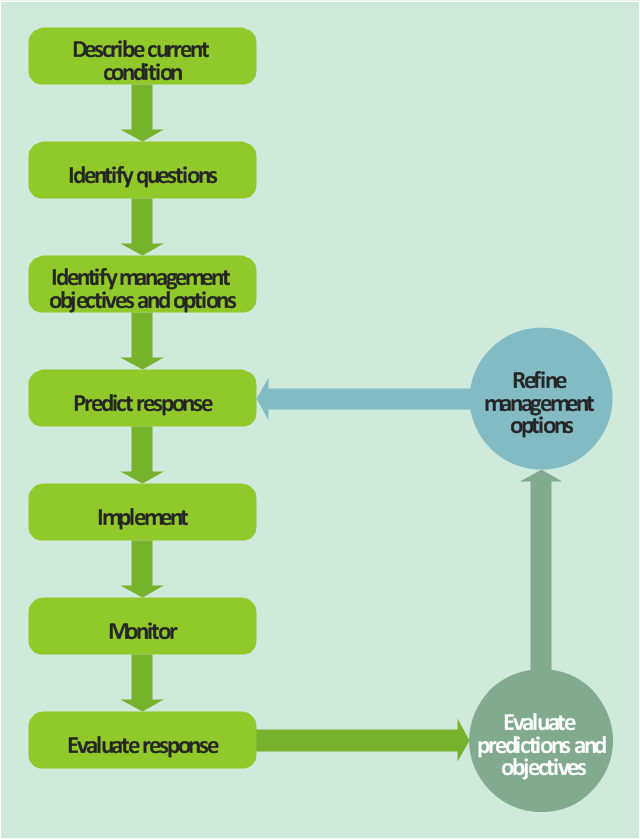LLNL Flow Charts
These flow charts help scientists analysts and other decision makers to visualize the complex interrelationships involved in managing our nation x2019.This TQM diagram sample was redesigned from the illustration of "Inland acid sulfate soil and water quality fact sheet" from website of the Department of the Environment of the Australian Government.
[environment.gov.au/ resource/ inland-acid-sulfate-soil-and-water-quality-fact-sheet]
"Adaptive management (AM), also known as adaptive resource management (ARM), is a structured, iterative process of robust decision making in the face of uncertainty, with an aim to reducing uncertainty over time via system monitoring. In this way, decision making simultaneously meets one or more resource management objectives and, either passively or actively, accrues information needed to improve future management. Adaptive management is a tool which should be used not only to change a system, but also to learn about the system (Holling 1978). Because adaptive management is based on a learning process, it improves long-run management outcomes. The challenge in using the adaptive management approach lies in finding the correct balance between gaining knowledge to improve management in the future and achieving the best short-term outcome based on current knowledge (Allan & Stankey 2009)." [Adaptive management. Wikipedia]
The TQM flowchart example "Acid sulfate soil adaptive management framework" was created using the ConceptDraw PRO diagramming and vector drawing software extended with the Total Quality Management (TQM) Diagrams solution from the Quality area of ConceptDraw Solution Park.
[environment.gov.au/ resource/ inland-acid-sulfate-soil-and-water-quality-fact-sheet]
"Adaptive management (AM), also known as adaptive resource management (ARM), is a structured, iterative process of robust decision making in the face of uncertainty, with an aim to reducing uncertainty over time via system monitoring. In this way, decision making simultaneously meets one or more resource management objectives and, either passively or actively, accrues information needed to improve future management. Adaptive management is a tool which should be used not only to change a system, but also to learn about the system (Holling 1978). Because adaptive management is based on a learning process, it improves long-run management outcomes. The challenge in using the adaptive management approach lies in finding the correct balance between gaining knowledge to improve management in the future and achieving the best short-term outcome based on current knowledge (Allan & Stankey 2009)." [Adaptive management. Wikipedia]
The TQM flowchart example "Acid sulfate soil adaptive management framework" was created using the ConceptDraw PRO diagramming and vector drawing software extended with the Total Quality Management (TQM) Diagrams solution from the Quality area of ConceptDraw Solution Park.
- Flowchart Accounting Journal To Balance Sheet
- Accounting Flowcharts | Accounting Data Flow from the Accounting ...
- Flowchart Definition | Financial Statement Balance Sheets Er Diagram
- Balancesheet Flow Chart
- Steps in the Accounting Process | How to Create Flowcharts for an ...
- How To Make Flowchart Of Balance Sheet
- Financial Statement Close Process Flowchart
- Accounting Data Flow from the Accounting Flowcharts Solution ...
- Trail Balance Flow Chart
- Flow Chart Of Trial Balance
- How to Draw an Effective Flowchart | The Best Flowchart Software ...
- Accounting Flowcharts
- Process Flowchart | Audit Flowchart Symbols | Types of Flowchart ...
- How to Make an Accounting Process Flowchart | How Do You Make ...
- Flowchart Represent The Financial Statements
- Design elements - Accounting flowcharts | Accounting Data Flow ...
- How to Draw an Effective Flowchart | Social Media Response | Blank ...
- Process Flowchart | Accounting Data Flow from the Accounting ...
- How to Create Flowcharts for an Accounting Information System ...
.jpg)
